Did you know that as many as 58% of employees spend 30 to 60 minutes of their workday on activities completely unrelated to their job? And another 33% waste 1 to 2 hours on workplace distractions.
To add to the frustration, manual spreadsheets don’t tell you how much time your team wastes. So, no one is held accountable — and distractions persist.
Read on for insightful workplace distraction statistics and tips to help you and your team minimize distractions once and for all.

Table of Contents
What is the most common distraction in the work environment?
The biggest workplace distractions are the smartphone and the Internet. Namely, a CareerBuilder survey found that US employers believe the following are the biggest distractors among their workforce:
- Cell phones: 49%
- Internet: 38%
- Social media: 37%
- Gossip: 35%
- Email: 29%
- Smoke/snack breaks: 25%
- Coworkers barging in: 24%
- Meetings: 23%
- Noisy coworkers: 19%
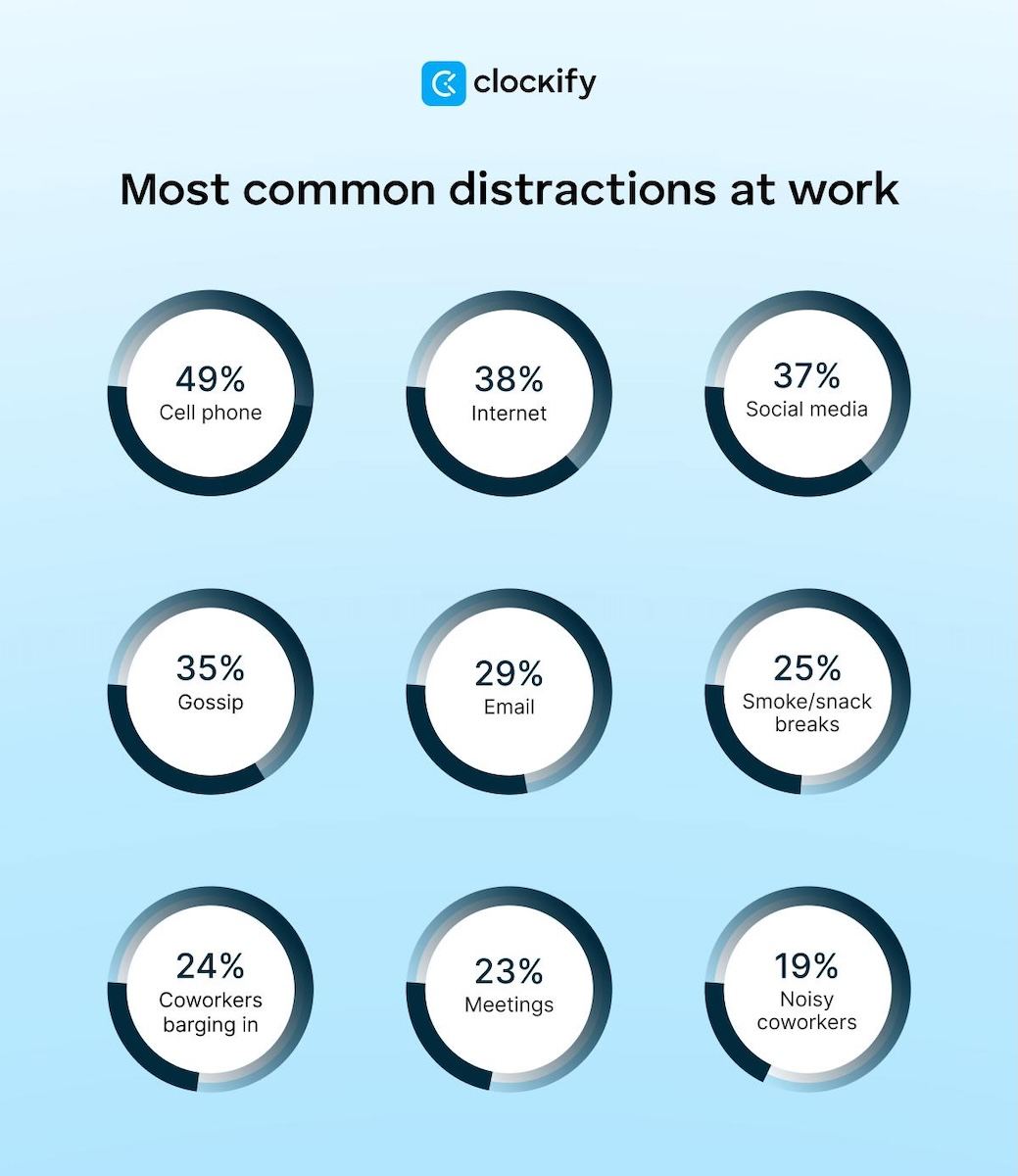
Of course, it’s impossible to eliminate every single distraction during the workday. But when they’re completely unmanaged, even the smallest interruptions can add up fast.
When employees get distracted at work, the company feels the cost. So, let’s see what else research has discovered about distractions in the workplace.
720 work hours a year are lost to workplace distractions
Research shows that employees lose about 720 hours a year due to workplace distractions.
And yet — it’s so easy to overlook the effects of distractions at work. Especially when you have no way of knowing how your team spends their time. Without the right timekeeping tool, neither you nor they are fully aware of all the hours wasted due to distractions.
It’s not just the time that’s slipping through the cracks — every year, US businesses lose about $650 billion because of distractions!
Save money with a time tracker
58% of employees waste up to an hour on workplace distractions
According to the 2025 Time-Wasting Report by Resume Now, more than half (58%) of employees waste between 30 minutes and 1 hour of their workday on non-work activities.
The rest spend the following amount of time distracted at work:
- 1 hour to 1 hour and 30 minutes (19% of employees),
- 1 hour and 30 minutes to 2 hours (14% of employees), and
- 15 minutes or less (6% of employees).
Interestingly, none of the respondents claimed they didn’t waste time at all.
The study about the effect of technology on cognitive functions explains that people simply can’t hold sustained attention for too long. The nature of the task, their interest, and motivation all contribute to the depth and length of focus.
Digital tools can increase our efficiency and help us stay connected. However, they have also increased the amount of work disruptions, triggering attention overload.
This “continuous partial attention” involves constantly shifting focus without fully engaging in tasks. The result is superficial understanding and reduced productivity.
Improve focus time with Clockify
127 hours a year are needed to regain focus after interruptions
Workers don’t only lose time while engaging in workplace distractions. They also spend 127 hours a year regaining their focus afterward, according to the Economist Impact report.
Additionally, the report found that workers typically spend 75 work hours a year on unproductive emails. Employees also waste 78 hours a year on inefficient meetings.
💡 CLOCKIFY PRO TIP
Don’t waste another minute on non-productive meetings! Read the article below for tips on how to reduce inefficient meetings with time tracking:
All this time spent on unproductive internal communication and refocusing after distractions adds up to hidden costs. As a project manager, if you notice frequent budget overruns, you need better insight into how work time is spent.
Inaccurate time data can also lead to undercharging clients. To avoid any financial issues, the first step is to introduce efficient time tracking to your team.
Track time accurately with Clockify
6 in 10 employees find digital tools distracting and stressful
According to Unily’s 2024 Digital Noise Impact Report, about 6 in 10 employees blame digital tools for increased workplace stress. The biggest culprits include:
- Video conferencing tools: 44%,
- Email: 39%, and
- Instant messaging apps: 36%.
As per the same study, managers seem to be the most stressed out by digital tools. Namely, 59% of managers reported being interrupted by a digital platform every 30 minutes or less, which was 11% more than other respondents.
73.2% of people find constant interruptions overwhelming
A Crucial Learning survey analyzed how people feel due to continuous workplace distractions. The results were eye-opening:
- 73.2% feel overwhelmed with how much they have to do,
- 73% feel completely drained,
- 72.6% feel worried and stressed,
- 71.7% feel that they’re inefficient,
- 54.2% feel unmotivated and unfulfilled, and
- 49.4% feel inadequate and disappointed.
These findings show that office distractions and interruptions negatively impact the team’s motivation, stress levels, and overall energy.
68% of people believe their workday includes too many interruptions
Based on Microsoft’s Work Trend Index report, 68% of people feel their workday doesn’t include enough uninterrupted focus time. Moreover, 62% of surveyed workers find searching for work-related information too time-consuming.
For the majority of respondents, inefficient meetings were one of the biggest triggers of distractions and productivity drop. Other problems included:
- Lack of clear goals,
- Too many meetings,
- Lack of inspiration, and
- Trouble finding the needed info.
70% of Gen Z employees get distracted by social media at work
According to a FlexJobs study, Baby Boomers are the most engaged generation in the workforce. The following generations reported being always or often engaged at work:
- 75% of Baby Boomers,
- 70% of Gen X, and
- 62% of Millennials.
However, despite their differences, no generation is immune to distractions. The same research showed that all generations get distracted, but the most common distractions at work vary:
- Unexpected meetings — Gen X (22%),
- Interruptions from coworkers — Baby Boomers (22%), and
- Office chatter — Millennials (21%).
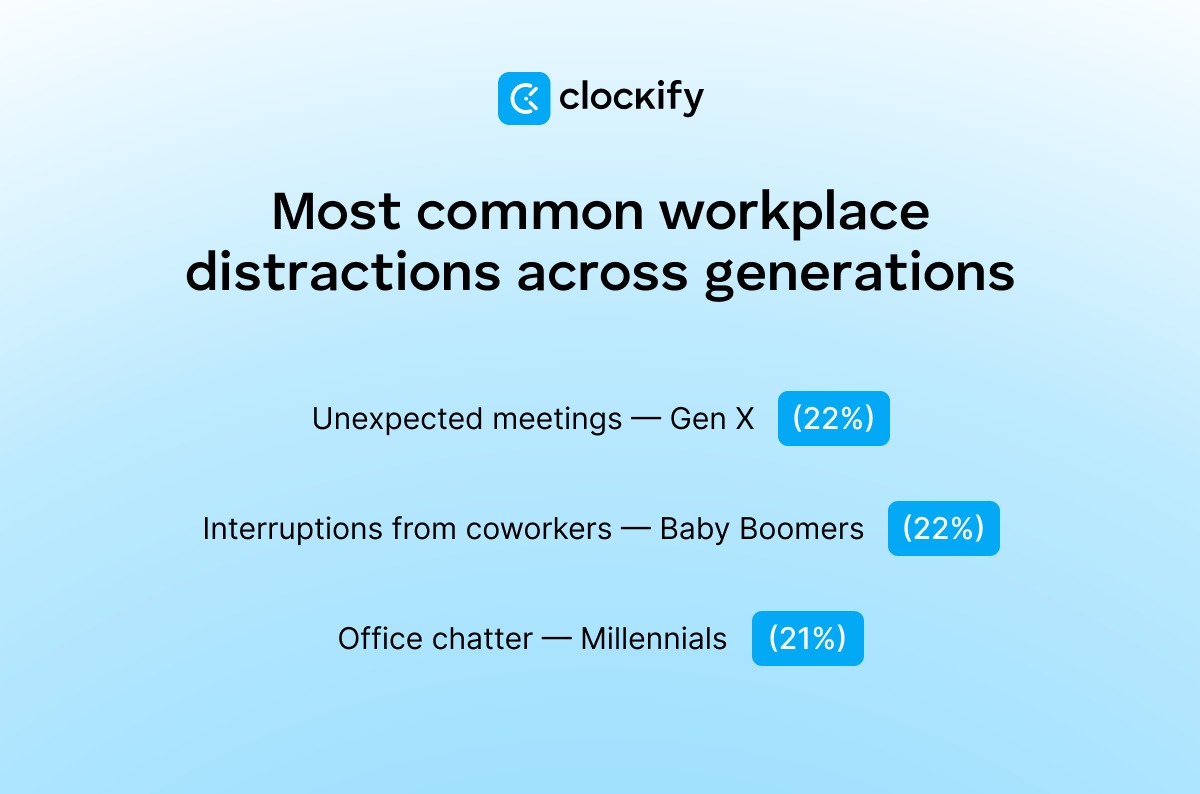
When it comes to Gen Z, a survey by Bevi revealed that their biggest distractions include:
- Social media: 70%
- Personal notifications: 64%
- Major news events: 62%
💡 CLOCKIFY PRO TIP
For compelling Gen Z statistics, check out this article:
About 50% of Gen Z employees watch TV shows during work hours
Do your projects constantly exceed the estimated timeline, while the deadlines are realistic? You may need to check in with your team to see if they’re actively working on their tasks.
Believe it or not, it’s quite plausible that half of your team is sneaking a peek at their favorite TV show while working.
In fact, a survey by the streaming service Tubi revealed that half of remote Gen Z workers get distracted by TV while on the clock. Also, as many as 48% admitted they hide their streaming habits from their superiors.
💡 CLOCKIFY PRO TIP
Learn how to tackle the biggest challenges of working remotely by reading the following article:
Workplace interruptions increase the chances of error by 12%
According to a study on the impact of interruption management on diagnostic decision-making, healthcare workers who were interrupted were 12% more likely to make errors. Furthermore, individuals failed to return to their original tasks 13-18% of the time after getting distracted.
It’s only natural — when you lack presence and engagement in what you do, you make mistakes more easily. Every single interruption that results in a mistake costs your team more time (and maybe even resources) to correct it.
76% of employers have taken action to minimize workplace distractions among their workers
Despite these worrying statistics, there’s still hope. A study by CareerBuilder showed that employers aren’t letting distractions completely diminish workplace productivity. In fact, a whopping 76% of employers are actively helping employees avoid distractions by:
- Blocking distracting websites (32% of employers),
- Banning cell phone use (26% of employers), and
- Limiting meetings (17% of employers).
As the team lead or operations manager, you can also help your team members minimize the distractions that are preventing them from reaching their full potential at work.
What exactly can you do about all of these distractions? Read on for tips on how to minimize and even prevent them.
10 tips on how to handle distractions at work
As a manager, you’re aware that your team has no time to waste. Now that you know the effects of distractions at work, here are some tips to reduce them team-wise.
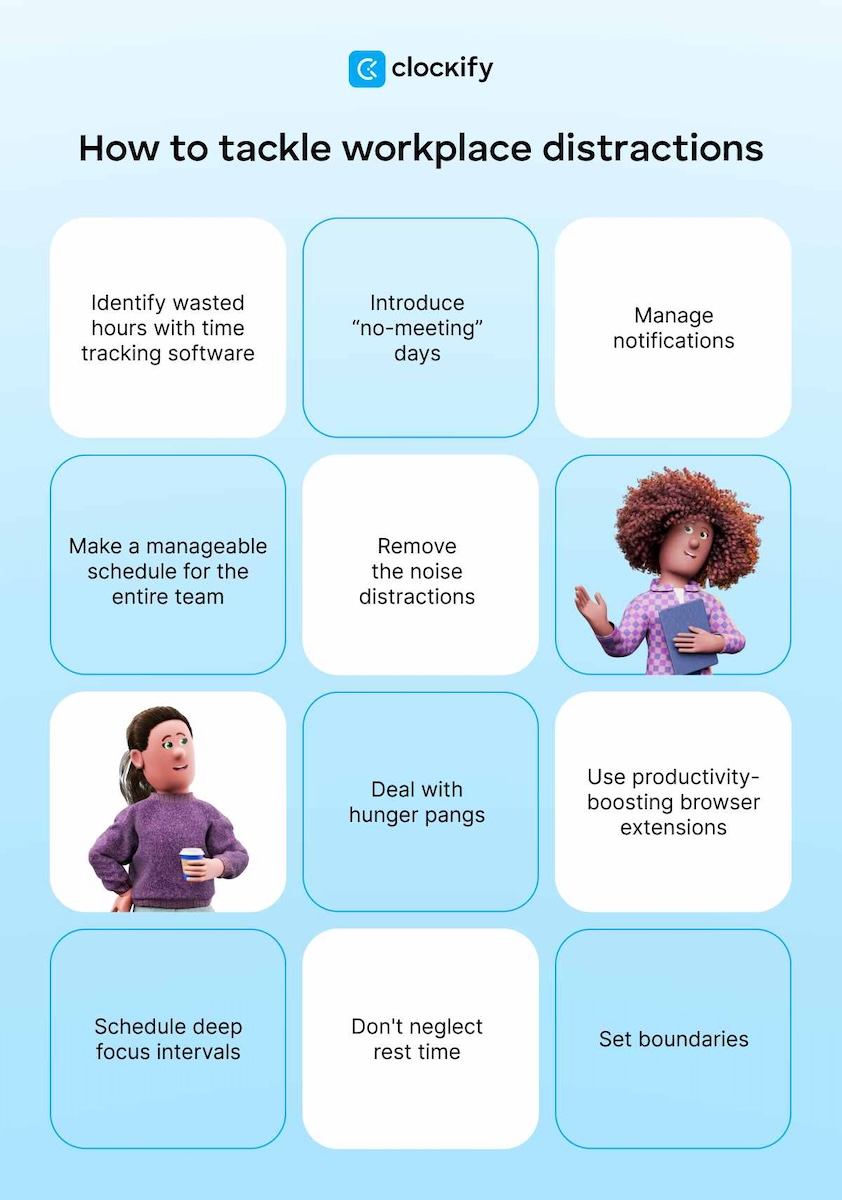
Tip #1: Identify wasted hours with time tracking software
Using a time tracking tool helps identify and avoid distractions within your team. In short, software tells you how your team members spend their time, and whether certain projects took them longer than expected.
This data gives you enough information to address time wasters within your team and improve productivity.
For example, if you rely on Clockify for time tracking, you get the following data:
- Hours worked on tasks,
- Labor cost based on tracked billable hours and set billable rates,
- Project progress details in real time (e.g., tracked time vs. estimated time), and more.
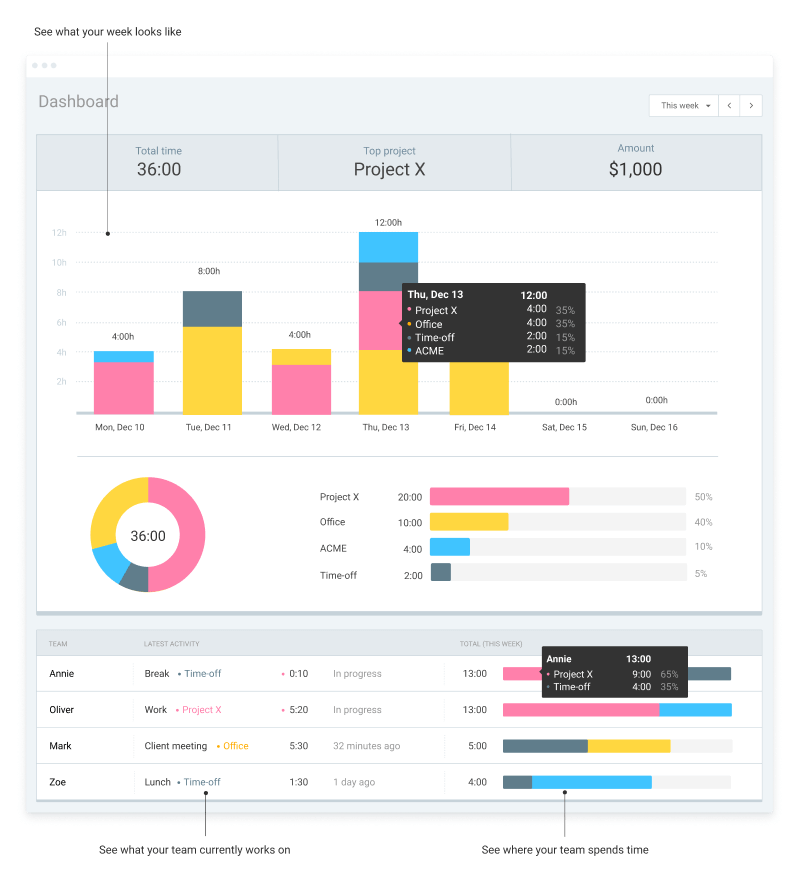
Accurate time data allows you to make better project budgets and timeline estimations as their manager. Clockify has a robust reporting feature, so you don’t have to calculate anything manually.
Tip #2: Introduce “no-meeting” days
One MIT study about the benefits of fewer meetings showed that reducing the number of meetings by 40% leads to:
- 71% increase in productivity, and
- 52% increase in satisfaction.
This paper recommends having at least 3 meeting-free days during a working week for optimal employee performance.
Automate meeting cancellations
Tip #3: Manage notifications
To effectively deal with distractions from apps, turn off unnecessary notifications, especially for your social media platforms. When you need to fully immerse yourself in your work, mute calls and texts on your phone as well. If you can’t resist checking your phone even with notifications off, try leaving it in another room.
The same goes for work-related notifications. If you’re constantly interrupted by email alerts, there’s no reason not to turn them off. Emails are inconvenient for urgent team discussions anyway, so it’s better to use a designated app for team communication.
Such apps typically allow you to mute alerts for groups you select, and leave them on for important channels or just direct messages.
Moreover, try to avoid checking your inbox at random. Instead, schedule fixed periods to check your inbox and respond to emails. For most teams, visiting the inbox 2–3 times a day is enough to stay connected without sacrificing deep focus time.
💡 CLOCKIFY PRO TIP
To truly master the art of email management, check out this article:
Tip #4: Make a manageable schedule for the entire team
If your team’s schedule isn’t precisely defined, it’s easy for team members to get lost in distractions. Workers manage time more effectively when they know when and how long they should work on each assignment.
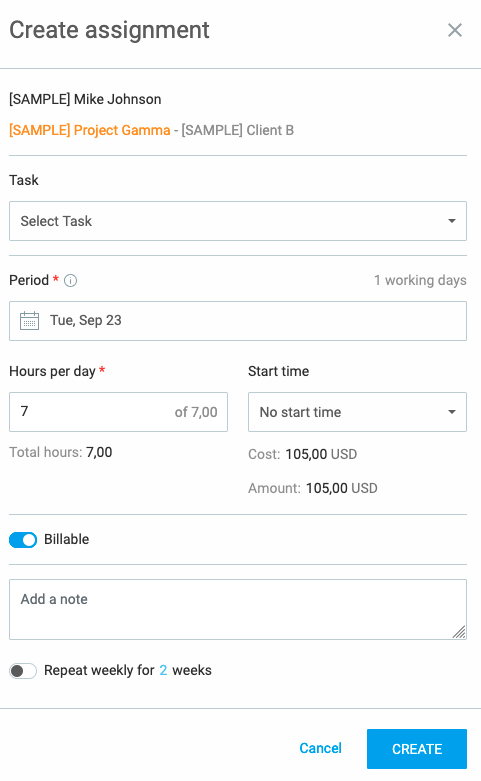
If detailed schedules aren’t an option, encourage your employees to create to-do lists for themselves. This way, they’ll focus on checking off their to-dos instead of reaching for their phone or chatting with colleagues.
Tip #5: Remove the noise distractions
Did you know that a whopping 86% of people feel more productive when they listen to music? So, chances are, music would help the entire team be more productive as well. You can’t go wrong with instrumental pieces or even game soundtracks.
To avoid distracting other employees in the office, encourage team members to use headphones when listening to music.
Those who prefer complete silence can use noise-cancelling headphones to mute distracting background noise. And for client calls in a crowded office, a microphone that absorbs and removes background sounds can be a great choice.
Tip #6: Deal with hunger pangs
Studies on the impact of a healthy diet on productivity suggest that adequate nutrition enhances work efficiency. Recommended healthy focus-boosting snacks include:
- Nuts, seeds, and dried fruit,
- Greek yogurt,
- Hummus, and
- Boiled eggs.
So, instead of eating a whole bag of chips, bring a bowl of healthy snacks for your team, and nibble when hunger strikes.
Tip #7: Use productivity-boosting browser extensions
When it comes to identifying distractions and improving productivity, you and your team can try browser extensions for:
- Tracking work time,
- Creating to-do lists, and
- Blocking distracting websites.
Extensions are great for reducing distractions because they don’t require you to leave your current tab. Thus, you’ll spend less time refocusing on your work.
For example, using an add-on for time tracking allows you to start the timer as soon as you open your browser.
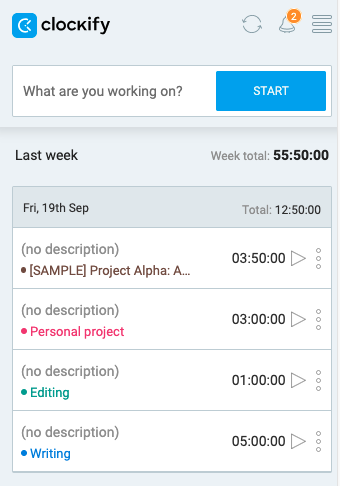
Website blockers ensure you don’t wander off to pages that aren’t related to your work assignments.
💡 CLOCKIFY PRO TIP
If you need a list of Chrome and Firefox extensions that improve productivity, take a look at these 2 articles:
Tip #8: Schedule deep focus intervals
You and your team can improve focus with the Pomodoro technique. Simply schedule deep focus intervals followed by mini-breaks.
To incorporate this productivity method effectively, try the Pomodoro timer in Clockify’s browser extension. This feature allows you to define the duration of your work sessions and breaks, and set notifications for both.
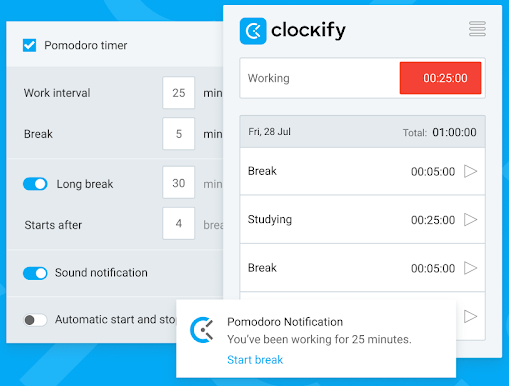
Copywriting editor at CAKE.com, Ivana Fišić, explains that she fits the Pomodoro method to her own needs by adjusting the work-break sessions:

“When I struggle to stay focused at work, I usually turn to the Pomodoro timer in Clockify. This way, I can break my day into work sessions, each followed by a brief break. Although the gist of the Pomodoro technique is to work for 25 minutes, and then have a 5-minute rest, sometimes it’s easier for me to work for 90 minutes and take a short break after every session.”
💡 CLOCKIFY PRO TIP
Interested in learning more about the great Pomodoro technique? Check out this blog post:
Tip #9: Don’t neglect rest time
One research study explored the link between taking breaks and better work performance. In short, a simple microbreak of less than 10 minutes increases employee productivity. These breaks were shown to be most effective for creative and clerical tasks.
Also, the study showed that the longer the break, the better the performance.
So, encourage your team to get enough rest. Some employees don’t realize that they get distracted way more frequently when they don’t give themselves time to recuperate.
💡 CLOCKIFY PRO TIP
To create an adequate leave policy, you need to get all the terminology right. If you’re confused about the difference between PTO and vacation, check out this article:
Tip #10: Set boundaries
We’ve already established that chatty coworkers are a major distraction. To avoid being constantly interrupted, set clear boundaries. This is easier in person — as you can simply explain to the whole team that you don’t have time to chat.
However, when you work from home, it’s more difficult to avoid constant direct messages, especially when you’re a manager. Luckily, some team communication apps allow you to set statuses.
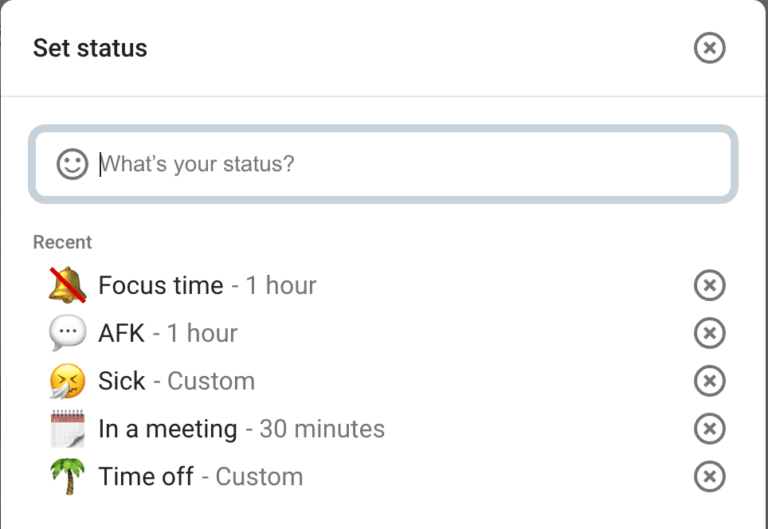
You can use this feature to inform the team that you’re only available for emergencies and specify the duration of your focus time. This ensures you’re not constantly interrupted when attending to urgent/important tasks.
Help your team overcome distractions — use Clockify
Even as a long-time team lead, you’re likely shocked by the mentioned statistics. You were probably aware that your team checks their phone from time to time. However, knowing how many workers totally succumb to distractions at work, including TV, social media, and office chat, is a hard pill to swallow.
But how do you hold your team accountable for wasted time if you have no concrete time data?
Look no further than Clockify — an all-in-one solution for tracking time spent on tasks. For starters, Clockify helps you track where your team’s time goes.
Apart from the timer and timesheets, the app also comes with an auto tracker that records the time spent on various apps and websites. This gives you and your team an overview of your work habits.
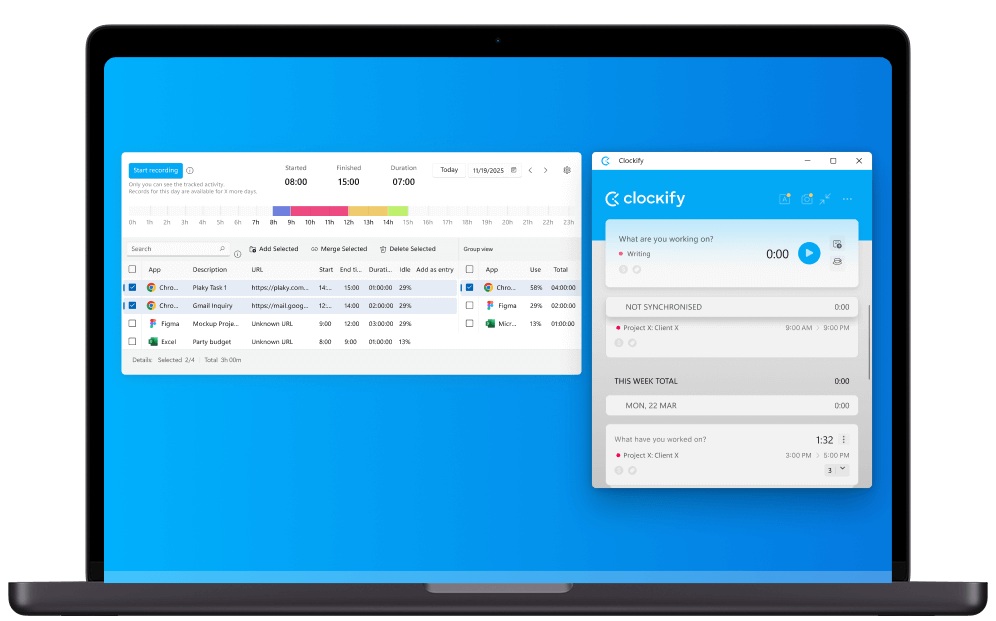
All you need to do is start the tracker, and Clockify will log your activity without any manual input. After reviewing the recorded data, you can convert it into time entries. If you choose not to, the data will stay private to you.
This is a great way to encourage your team members to work on their productivity as well. They can use the auto tracker to identify distractions. And once they create time entries, you get valuable insight into team efficiency.
After you and your team eliminate distractions and become more productive, you’ll see the profit go up.
Don’t let distractions diminish your productivity. See how Clockify can transform your workflow.
REFERENCES
License for research: https://creativecommons.org/licenses/by-sa/4.0/
- Albulescu P. et al. (2022). “Give me a break!” A systematic review and meta-analysis on the efficacy of micro-breaks for increasing well-being and performance. PLoS One. 31;17(8):e0272460. doi: 10.1371/journal.pone.0272460.
- Laker, B. et al. (2022). Days Without Meetings – A Way to Be Productive. MIT Sloan Management Review. ISSN 1532-9194.
- Mahendika D. et al. (2025). The Relationship of a Healthy Diet With the Level of Productivity Among Office Workers. Oshada. 2. 1-12. doi: 10.62872/91rc6656.
- Shanmugasundaram M. & Tamilarasu A. (2023). The Impact of Digital Technology, Social Media, and Artificial Intelligence on Cognitive Functions: A Review. Front. Cognit. 2:1203077. doi: 10.3389/fcogn.2023.1203077.
- Sloane J. F. et al. (2023). Managing Interruptions to Improve Diagnostic Decision-Making: Strategies and Recommended Research Agenda. Journal of General Internal Medicine. 38(6):1526-1531. doi: 10.1007/s11606-022-08019-w.





